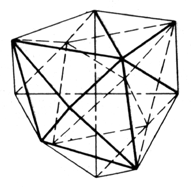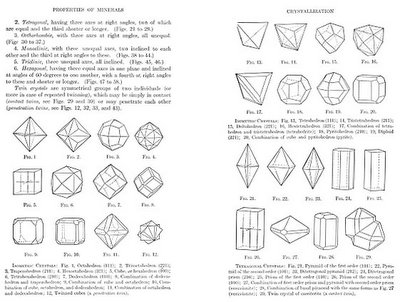A Natural History of Mirrors
In Crystallography, poet Christian Bök describes "a medieval treatise on the use of mirrors." This treatise, Bök tells us, suggests that when two mirrors reflect one other, the endless abyss of mirrors-in-mirrors created between them might form a kind of spectral architecture.

Further, the medieval treatise says, "any living person who has no soul can actually step into either one of the mirrors as if it were an open door and thus walk down the illusory corridor that appears to recede forever into the depths of the glass by virtue of one mirror reflecting itself in the other. The walls of such a corridor are said to be made from invulnerable panes of crystal, beyond which lies a nullified dimension of such complexity that to view it is surely to go insane. The book also explains at length that, after an eternity of walking down such a corridor, a person eventually exits from the looking-glass opposite to the one first entered."
And it gets more interesting:
The treatise's author, Bök explains, "speculates that a soulless man might carry another pair of mirrors into such a corridor, thereby producing a hallway at right angles to the first one, and of course this procedure might be performed again and again in any of the corridors until an endless labyrinth of glass has been erected inside the first pair of mirrors, each mirror opening onto an extensive grid of crisscrossing hallways, some of which never intersect, despite their lengths being both infinite and perpendicular."
The author of the treatise warns, however, that one could become "hopelessly lost while exploring such a maze" – for instance, "if the initial pair of mirrors are disturbed so that they no longer reflect each other, thus suddenly obliterating the fragile foundation upon which the entire maze rests."
In which case whole crystal cities of mirrored halls, in right-angled topologies of non-self-intersecting self-intersection, would simply disappear – along with anyone exploring inside them.

A kind of rogue experiment might ensue, aboard the International Space Station: an astronaut, crazed with loneliness, sets up two mirrors... and promptly escapes into a hinged labyrinth of crystallized earth-orbiters, his radio crackling unanswered in the control panel left behind.

Further, the medieval treatise says, "any living person who has no soul can actually step into either one of the mirrors as if it were an open door and thus walk down the illusory corridor that appears to recede forever into the depths of the glass by virtue of one mirror reflecting itself in the other. The walls of such a corridor are said to be made from invulnerable panes of crystal, beyond which lies a nullified dimension of such complexity that to view it is surely to go insane. The book also explains at length that, after an eternity of walking down such a corridor, a person eventually exits from the looking-glass opposite to the one first entered."
And it gets more interesting:
The treatise's author, Bök explains, "speculates that a soulless man might carry another pair of mirrors into such a corridor, thereby producing a hallway at right angles to the first one, and of course this procedure might be performed again and again in any of the corridors until an endless labyrinth of glass has been erected inside the first pair of mirrors, each mirror opening onto an extensive grid of crisscrossing hallways, some of which never intersect, despite their lengths being both infinite and perpendicular."
The author of the treatise warns, however, that one could become "hopelessly lost while exploring such a maze" – for instance, "if the initial pair of mirrors are disturbed so that they no longer reflect each other, thus suddenly obliterating the fragile foundation upon which the entire maze rests."
In which case whole crystal cities of mirrored halls, in right-angled topologies of non-self-intersecting self-intersection, would simply disappear – along with anyone exploring inside them.

A kind of rogue experiment might ensue, aboard the International Space Station: an astronaut, crazed with loneliness, sets up two mirrors... and promptly escapes into a hinged labyrinth of crystallized earth-orbiters, his radio crackling unanswered in the control panel left behind.





Comments are moderated.
If it's not spam, it will appear here shortly!
Just for the record here, the phrase "a natural history of mirrors" comes from Bök's book.
Hi Geoff
Reliably fascinating site. You might be interested in "Mirrors In Mind"-Richard Gregory, "The Claude Glass" -Arnaud Maillet and "The Art Of Memory"-Francis Yates.
Some of this touches on a recent project of mine which you can see at:
gardenofinstruments.com
keep it up!
regards
Paul Schütze
Paul - Thanks for the tips! I know your work, actually; many lifetimes ago there was a record shop I frequented and the owner was a fan of yours. "New Maps of Hell" is a title I can't forget... The Garden of Instruments sounds fascinating, by the way. I'd love to hear more about it.
PS: U2 is Album of the Year? Would be interested in your opinion on that one...
Terry Pratchett used the lost between two mirrors idea in his book "Witches Abroad". One witch's advice to young ladies was "Always get the gentleman's name, and never stand between two mirrors."
Not sure I want to go on record with an opinion about U2 being "album of the year" except perhaps to reflect on what a desolate prospect that would be if it were in fact true. Fortunatly it isn't.
The GOI project I mentioned is an extrapolation of the sound work I made a few years back around the Janta Manta in Delhi. Part of a series of works about the experience of built environments as distinct from descriptions of structures. Hence the concern with memory, reflection, internal weather systems, haptic narratives etc. I'm finding a great deal here on your site which connects with these themes. All great!
Paul - If you haven't already found them, these posts might interest you: listening to the seismology of 9/11. The very end of this post. Or this one, on geoacoustics, proposing an MP3 of the surface of Mars.
On contact mic'ing the foundations of London, including icebergs as instruments. On podcasting the sun. On weather as an instrument via landscape architecture.
Glad you found the site, meanwhile. Any way to hear the garden of instruments yet? (Need any writing for it?)
And, anonymous, was the advice about not standing between two mirrors so that the character would avoid getting trapped in there...? Or just a beauty tip...? Curious.
Three words. Okay, Five.
You. Have. The. Best. Blog.
Six: Ever.
Your mind is wild, and it keeps touching on the kinds of things my mind gravitates to. Don't ever quit.
Really, it's just the best.
Sean Wolfe
Thanks for the refs. I will look at them over the weekend.
T G O I was originaly released as Second Site on Virgin. It preceeded a work on Peter Zumthor's Spa in Vals which also developed into a built instalation work ( see "Third Site") several years ago. We have reissued it through the site. Email me your details through my site and I will sort you out.
Are you familliar with Edward Burtinski's photographs?
Two things: it is a previously unknown fact that Kubrick put two mirrors face to face in developing the idea for the monolith in 2001. Thus, the film is about what happens behind the space created by internal reflection. Similarly, Jules Verne had an idea about using mirrors for space travel, where the infinite reflection travels an infinite distance in negligible time. This was derived from a story by Poe involving a man trapped between two mirrors by the infinite distance between himself and his reflections, something along the lines of Zeno's paradox. Zeno himself got in on the act with a set of curved mirrors. Not in relation to burning ships, but as a means of reproducing objects, somewhat like a combination of Star Trek transporter and a hologram. You've seen the modern equivalent in those covered mirror bowls that project an object's reflection into the ocular space of the bowl. But he went mad after climbing inside a large version in the attempt to project himself into two places at once.
Thanks, Sean; feel free to tell others...
And Paul, I do indeed know Burtynsky's work. It pops up here and there on the blog, in fact; see Where cathedrals go to die for starters. I'll take a look at "Third Site," meanwhile. But feel free to come back in future.
And e-tat, interesting points as usual. There is another little story in Bök's book about a man at a Lacan conference who gets trapped in a mirrored elevator overnight; he gradually goes insane, claiming, upon rescue, that they saved the wrong person and that he is actually still back there in the elevator. Similarly, I remember a Japanese short story I read about a decade ago about a man who gets trapped in a glass sphere he designs for himself. A mirrored sphere, I should say; the inside is mirrored. It rolls around, and he goes nuts, as per the standard trope. I can't remember how light was supposed to have entered its confines, on the other hand...
..I posted this
http://watchinmewatchinu.blogspot.com/
2004/12/category-optical-illusions-property.html
..finding a reference to peppers ghost which intriged me!
Post a Comment